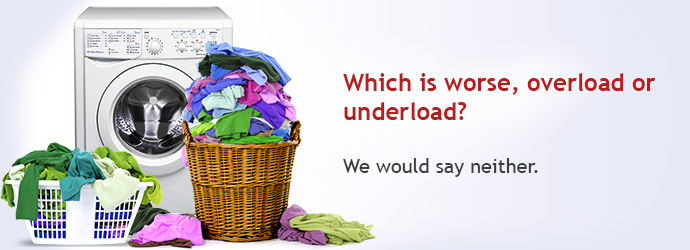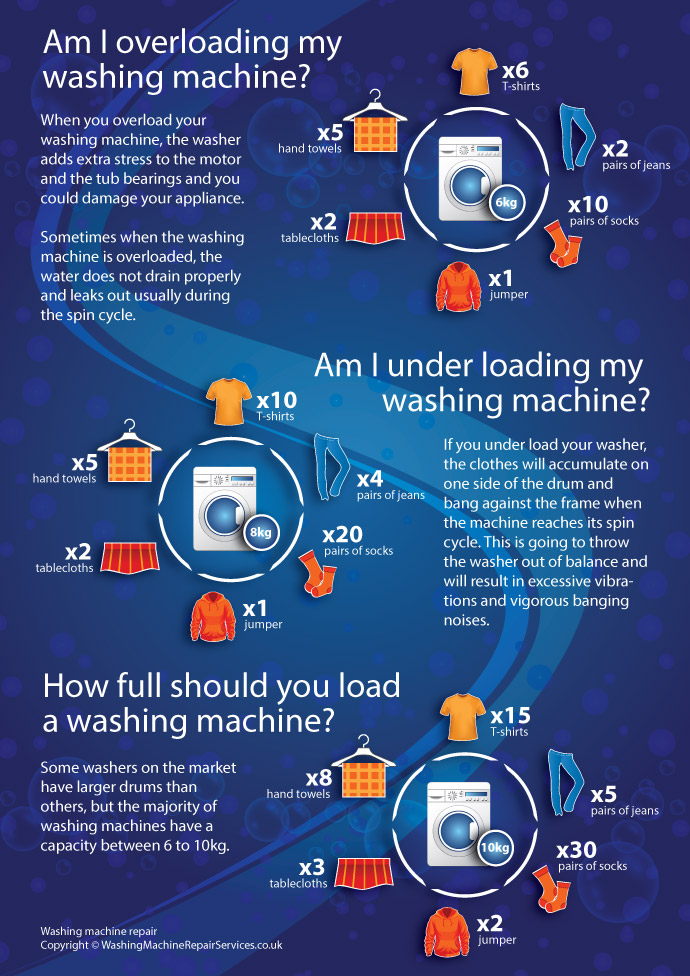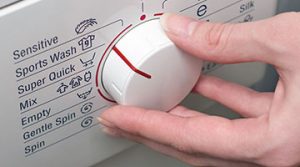Can you break the appliance by overloading it?
Can this really be true?
The clothes need space for the laundry detergent to move through them and should be distributed evenly and loosely inside the drum. If you overload the washing machine, clothes won’t be free to move around and get clean, because they can’t be properly soaked in water and laundry detergent. In addition, when you overload your washing machine, the washer adds extra stress to the motor and the tub bearings and you could damage your appliance.
Overloading your washing machine means not only your clothes not getting as clean as you would like, but stressing the washer could throw the spinning drum out of alignment. Washing machine drums also have a weight limit and overloading your washer on a regular basis can damage the motor as well. Sometimes when the machine is overloaded, the water does not drain properly and leaks out usually during the spin cycle.

Why you shouldn’t under load your washing machine too?
If you under load your washer, the clothes will accumulate on one side of the drum and bang against the frame when the machine reaches its spin cycle. This is going to throw the washer out of balance and will result in excessive vibrations and vigorous banging noises. We hope you find these tips helpful, but if your appliance has already broken down please book a washing machine repair with one of our expert engineers.
How full should you load a washing machine? Am I overloading or under loading my washing machine?
Some washers on the market have larger drums than others, but the majority of washing machines have a capacity between 6 to 10kg. What does it means? Well, in most cases 7kg is equivalent to 35 T-shirts and 8kg is equivalent to 40 T-shirts. Generally speaking, a model with a 7kg capacity will comfortably serve a medium sized household, while models with a 6kg capacity are large enough to cope with the needs of 1-2 people. Washers with drum capacities above 10kg are ideal for larger households.
So what is the answer?
We recommend that you should fill the drum of the washer, but ensure that there is a reasonable space between the top of the pile and the drum. Always read the manufacturer’s instructions carefully and follow them.
Washing machine load weight guide
While drum capacity is measured in kilograms, we don’t always think of our laundry loads in terms of weight. You can use the bathroom scale and measure the weight of all the clothes you’d normally push into one wash load. The weight of the clothes depends on the size and the type of material used and all of these factors affect wash load. Below we have provided an estimated guidance and please note this is only an approximate guidance and can change depending on material used.
- Drum size: 6kg
5 hand towels, 6 T-shirts, 2 pairs of jeans, 1 jumper, 10 pairs of socks or underwear, 2 bed sheets - Drum size: 7kg
5 hand towels, 10 T-shirts, 4 pairs of jeans, 1 jumper, 20 pairs of socks or underwear, 2 bed sheets - Drum size: 10kg
8 hand towels, 15 T-shirts, 4 pairs of jeans, 2 jumpers, 30 pairs of socks or underwear, 3 bed sheets
Please always follow the manufacturer’s instructions for maximum and minimum load weights.
Washing machine drum sizes and capacities explained – Infographic (download here)
A useful tip:
Have you noticed an awful mould odour coming from your washing machine? Find out how to clean your washing machine.
Get in touch with WM Repair Services
Whatever appliance you have and whatever age it happens to be, you now have easy access to a service you can count on. Our engineers provide repair solutions for all makes and models.
Call 020 3745 7452
Our advice and quotations are free. Whatever it is, just give us a call.
In addition to washing machines, we specialise in repairing a variety of home appliances. Our services include:




